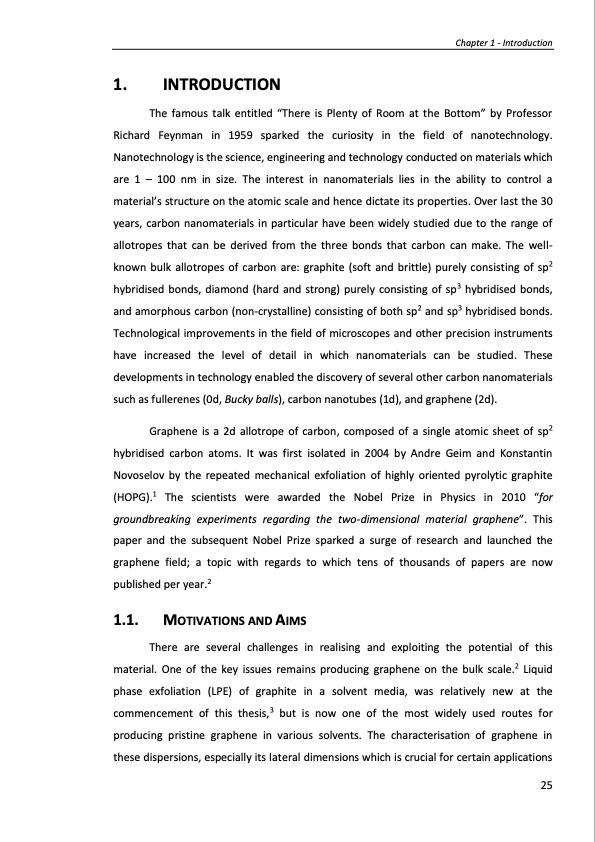PDF Publication Title:
Text from PDF Page: 025
1. INTRODUCTION The famous talk entitled “There is Plenty of Room at the Bottom” by Professor Richard Feynman in 1959 sparked the curiosity in the field of nanotechnology. Nanotechnology is the science, engineering and technology conducted on materials which are 1 – 100 nm in size. The interest in nanomaterials lies in the ability to control a material’s structure on the atomic scale and hence dictate its properties. Over last the 30 years, carbon nanomaterials in particular have been widely studied due to the range of allotropes that can be derived from the three bonds that carbon can make. The well- known bulk allotropes of carbon are: graphite (soft and brittle) purely consisting of sp2 hybridised bonds, diamond (hard and strong) purely consisting of sp3 hybridised bonds, and amorphous carbon (non-crystalline) consisting of both sp2 and sp3 hybridised bonds. Technological improvements in the field of microscopes and other precision instruments have increased the level of detail in which nanomaterials can be studied. These developments in technology enabled the discovery of several other carbon nanomaterials such as fullerenes (0d, Bucky balls), carbon nanotubes (1d), and graphene (2d). Graphene is a 2d allotrope of carbon, composed of a single atomic sheet of sp2 hybridised carbon atoms. It was first isolated in 2004 by Andre Geim and Konstantin Novoselov by the repeated mechanical exfoliation of highly oriented pyrolytic graphite (HOPG).1 The scientists were awarded the Nobel Prize in Physics in 2010 “for groundbreaking experiments regarding the two-dimensional material graphene”. This paper and the subsequent Nobel Prize sparked a surge of research and launched the graphene field; a topic with regards to which tens of thousands of papers are now published per year.2 1.1. MOTIVATIONS AND AIMS There are several challenges in realising and exploiting the potential of this material. One of the key issues remains producing graphene on the bulk scale.2 Liquid phase exfoliation (LPE) of graphite in a solvent media, was relatively new at the commencement of this thesis,3 but is now one of the most widely used routes for producing pristine graphene in various solvents. The characterisation of graphene in these dispersions, especially its lateral dimensions which is crucial for certain applications Chapter 1 - Introduction 25PDF Image | PRODUCTION AND APPLICATIONS OF GRAPHENE AND ITS COMPOSITES

PDF Search Title:
PRODUCTION AND APPLICATIONS OF GRAPHENE AND ITS COMPOSITESOriginal File Name Searched:
graphene-production-applications.PDFDIY PDF Search: Google It | Yahoo | Bing
Salgenx Redox Flow Battery Technology: Power up your energy storage game with Salgenx Salt Water Battery. With its advanced technology, the flow battery provides reliable, scalable, and sustainable energy storage for utility-scale projects. Upgrade to a Salgenx flow battery today and take control of your energy future.
CONTACT TEL: 608-238-6001 Email: greg@infinityturbine.com (Standard Web Page)